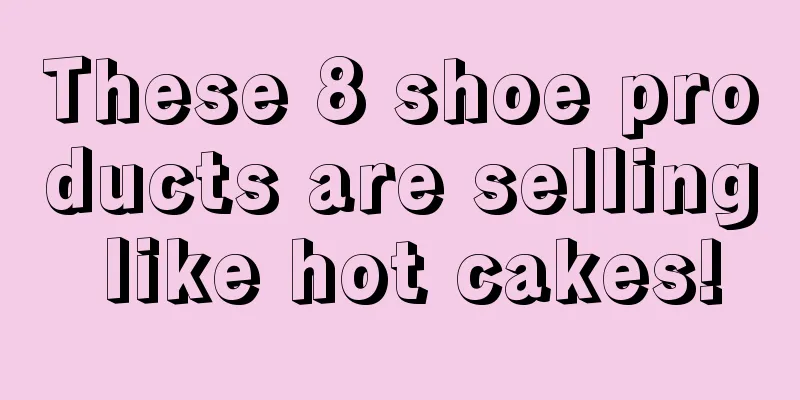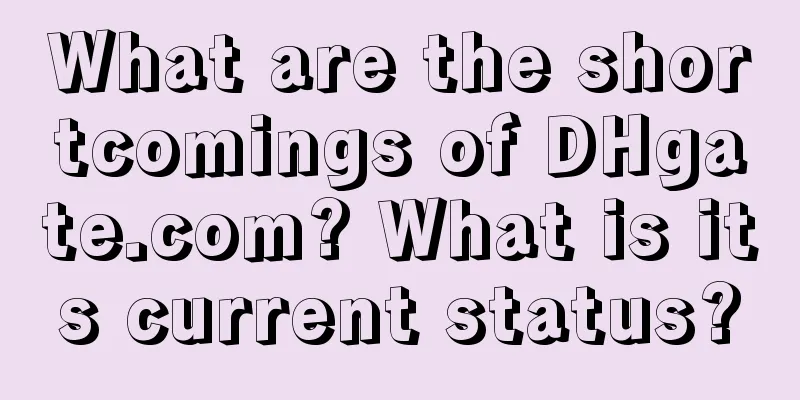Super practical consumer psychology from an e-commerce boss, increasing conversion rate by 100%!

Selling goods, selling goods, and selling goods through e-commerce must deal with consumer psychology. These days, who hasn't read a few books and articles on this subject? In this regard, I will not teach you about theories, principles, and methodologies. But we, the local e-commerce bosses, also have a complete and useful set of consumer psychology, which is mainly applicable to opening e-commerce stores, advertising, and improving corresponding link conversions. However, I think this content is too simple, crude, and not up to standard, and not worth writing books or giving lectures on. But it is absolutely practical enough. If it can be implemented well, the conversion rate of the entire marketing and sales can definitely be increased by 100%. Well, today I will use actual cases to share with you what consumer psychology is like in the minds of local e-commerce bosses . 1. The first level: attracting attentionThis set of consumer psychology is mainly based on the user's complete shopping path. For example, a consumer opens Taobao and wants to buy a product. What should she buy? Oh, yes, she wants to buy a small bag! Okay, she opened Taobao and searched for women's bags. This is the first stage of consumer psychology. The consumer will be faced with a huge number of products. How can you impress them? At this time, consumers will be faced with a huge number of products, including your product. How to make consumers choose you from a huge number of products and click on you instead of just swiping past them? It’s nothing more than three key points: picture + price + number of payers. At least at the beginning, consumers' psychological demands are really simple. 1. The picture should be good lookingIt must be eye-catching, unique, and more advanced than others. Good-looking pictures naturally represent advanced and high-quality products, which makes people more willing to click. In the examples below, I believe you can tell which picture is more eye-catching and more clickable. 2. The price should be rightYour price is in line with her daily consumption habits and target budget, so it will naturally become her priority reference item. Of course, we are not saying that we must lower prices, work hard to lower prices, and engage in price wars every day. Even if you don't offer low prices, you should focus on the mass price range. After all, the popular price range will make more consumers consider your products as a priority. Many people who start a business insist on going high-end from the start and selling their products at very high prices. At this stage, consumers simply pass on the products because they cannot afford them. 3. More people should payThis is also very important. If hundreds or thousands of people have paid for your product, it will appear more attractive in the minds of customers, because consumers are herd-followers after all. They will think that many people are buying this product, so it must be very good, and they also want to go in and take a look. If only a few, a dozen, or even zero people pay for your product, then even if the visuals are beautiful and the price is low, consumers may not click on it, and may even leave in a hurry after clicking. Because no one wants to be the first person to try something new. My prices are higher than yours, my pictures are not as good-looking as yours, and I have fewer payers than you. If you were a consumer, would you choose me? In addition to visuals, prices, and the number of people who have paid, some of the trivial little labels added by the system are also important. For example, whether there is freight insurance, free shipping, ready for sale, an [ifashion] label (this label represents that the store is a leader in the platform's fashion tone), etc., will also invisibly increase customers' click-through rate. So in the first level of consumer psychology, what most people can do is ranked in order of difficulty: 1. Don’t go for high-end products right away. Instead, prioritize entering the mass price range and make your products as price competitive as possible. 2. Improve your aesthetic sense, work hard on your vision, and create visual art that surpasses your competitors. 3. It is best to have some resources, such as anchors, or some seed users, who can help you increase the number of paying users for your product at the very beginning, to dozens or hundreds of people, so that it does not appear so thin. If you can do the above points well, the probability of consumers clicking on your product will greatly increase. She has entered your product link and now enters the [second level]! 2. Second level: Home page informationWhen consumers click on the link, they will first see your link sales. Of course, the more data the better, so some merchants increase their sales by fake orders. For example, for a product in the picture below, the external display shows that the number of people who have paid is 300, but after clicking on it, the sales volume is over 10,000. The difference is too large, so it is possible that the data is manipulated. After looking at the sales volume, consumers will take another look at the price . If the price is more favorable, such as a price after discount or a price exclusive for new customers, consumers will be more willing to place an order. After seeing the price, consumers will first seek to watch the short video of your product. At present, short videos have become the most important means for consumers to understand products. Good short videos can not only help customers quickly understand products, but also be more effective than pictures in terms of seeding. Therefore, basically, good product links must be equipped with short videos. Consumers must be given what they want to see. Well, after watching the short video, consumers who are more interested in the product will slide the pictures and look at the 5 main pictures. These 5 main pictures are also very important, and the display logic is also different. For example, categories like clothing, bags, and accessories have relatively poor functional materials and are more about displaying beauty, so the five product pictures are all about displaying the beauty of the products, with the focus on continuing to stimulate consumers' desire to buy. For categories like bags and clothing, the 5 main pictures are simple and mainly show the beauty of the products. For some products that require detailed explanation, it is necessary to use 5 main pictures to quickly explain the core selling points of the product. At this stage, many consumers are too lazy to look at the product details page. If five main pictures + a video can help them understand the product information clearly, they will directly complete the order. So again, shelf e-commerce is also a visual art in a sense. Customers search for pictures, videos, and five main pictures. When doing shelf e-commerce, there is no upper limit to the improvement of visual effects. Well, in addition to the picture and video area above, the product service description area is also very important. In this area, consumers will focus on the following points. The following area is also the focus of consumer psychology: The most important point is whether the product is in stock and can be shipped quickly after payment. This is the issue that consumers are most concerned about and is also the key factor affecting conversion rate. After all, no one has much patience these days and everyone hopes that the product will arrive as soon as they buy it. They wish to buy it today and have it arrive today. If the pre-sale period of your product is too long, such as more than ten days or dozens of days before delivery, it will inevitably affect conversion. The second thing is whether it supports [seven-day no-reason return] and whether it supports [free shipping]. There is no problem with this, and basically everyone can do it. What we will pay more attention to are some more detailed services, such as whether [freight insurance] is given as a gift, whether [quick refund] is given, whether [four times compensation for fake goods] is supported, etc. These more meticulous services will continue to deepen customers' sense of security when shopping. 3. The third level: word-of-mouth evaluationWell, generally speaking, after reading the above information, consumers will begin to experience the first wave of diversion. A small number of customers will simply leave because they are not interested, have waited too long, and don’t want to continue watching. Many people think that customers will go to the product details page next. But for consumers, browsing the product details page has become a very heavy and tedious task. If you want to learn about a product as quickly as possible, it is easier to read reviews. This is the third stage of consumer psychology. In this link, several key points are very important. The first is the [number of reviews]. The more this number is, the more people buy it, and the consumer’s sense of security increases by +1. The second is the evaluation displayed. Because at this stage e-commerce platforms will give priority to displaying recent or high-quality reviews, it is important to ensure that the reviews are positive about the product. Just think about it, if consumers see bad reviews or complaints in this area, they will probably leave directly. Then, consumers will give priority to the buyer show collection below. After all, buyer shows are what consumers want to see the most. Merchants can create this buyer show collection. The benefits of this collection are: If it is done well and all the pictures displayed are high-quality products, then after customers have viewed the collection of buyer shows, they will not think about clicking on the review area to see more reviews. Because consumers are afraid of trouble, after seeing a few good reviews and some beautiful photos, they can basically pass the test based on their understanding in the review section. There may be negative reviews in your evaluation, but consumers will not see them and will not be affected. But if you don’t have this buyer show collection, consumers won’t be able to see the pictures, so they will click on the comment area to see if anyone has posted a picture . At this time, the bad reviews in the evaluation area will also be seen by consumers, thus affecting your conversion. Next, customers will go to [Ask Everyone]. This module has now become a very important link in influencing consumers' psychology, so now many businesses, including me, will arrange to ask everyone in advance, and ask and answer questions by themselves, trying to guide consumers as softly as possible. 1. About evaluationEvaluation has always been the most important factor affecting consumer psychology. All your ideas about the product’s vision, images, marketing, positioning, placement, and creation may be ruined by a few bad reviews. Many times, an advertisement costing millions of dollars may not be as effective as a few customer reviews. Therefore, in order to avoid this place from having a negative impact on consumers' shopping psychology, all e-commerce operations have invested a lot here. The first thing is to eliminate negative reviews . Any negative reviews that may affect product conversions must be strictly guarded against. If negative reviews are found, compensation can be communicated. If they are for returns, we must do everything we can to get customers to delete them. If you really can't delete it, you need to give more positive reviews to suppress it. The second thing is to do a high-quality buyer show. Many people would say that a merchant’s high-quality buyer shows would appear fake because they do not look like they were taken by users, and it is impossible for users to take such beautiful pictures. That being said, we still have to do it, because the buyer show of high-quality products may not necessarily convince customers, but it will still subtly make consumers feel that the product is high-end and exquisite, and will awaken their desire to buy it. It’s like when you go to buy a house. Even if you know that the decoration of the developer’s model house is fake, it will still make you look forward to the future. The following is a buyer's show of high-quality products from a women's bag merchant's own shop: After displaying the high-quality buyer shows, you also need to display the real, not-so-good-looking buyer shows, or the amateur buyer shows. The purpose of this kind of buyer show is to awaken the consumer's sense of involvement. The consumer will feel that although the amateur buyer show is not exquisite enough and not that good-looking, it does not look that bad, and this product is indeed bought by real consumers, so I don’t have to worry too much. This mix of exquisite buyer shows and amateur products will give consumers a more comprehensive reference. The next step is to write a long text review. This kind of long text review should have a product review feel, with more words, neutral content, and the entire writing tone should be a bit like that of a reviewer. Beauty products generally have a lot of long text reviews: Although the text is long, it will give consumers a sense of immersion and a detailed usage experience of others who have purchased the product. In addition to long text reviews, short text reviews should also be laid out alternately, such as:
When these short positive reviews are spread out, the authenticity of the review area will be enhanced, because real consumers generally give positive reviews in just a few words, and are frugal with words. I have talked about this part in great detail, hoping to tell you that the evaluation stage is the most important one that affects consumers' psychology. In this stage, giving consumers rich feedback that makes them feel aspirational, involved, and real can make consumers more motivated to place orders. Many times, a good buyer’s show or a good long review can have a terrifying effect in improving conversion rates. 2. Shop aroundAfter the evaluation stage, the trend of consumer diversion becomes more obvious; Some consumers have left due to a small number of reviews, bad reviews, no buyer's show, poor quality of buyer's show, etc. Some consumers will directly search for the same product, trying to find a cheaper one. Comparing prices from different stores before buying is the most basic psychology of consumers. For this part of consumers, as long as we make our modules perfect, they will come back automatically. We have to ensure that the visual quality of our products, although not absolutely leading, at least has advantages, such as higher definition, more exquisite, or more artistic. If the competitor's product of the same model is not as good as mine in terms of visual appearance, for example, the image is stolen and not clear, the image pixels are very poor, or even in order to get rid of the accusation of stealing the image, the head and the logo are erased, etc., then consumers will definitely not buy them. They are also afraid of encountering fakes and will definitely return to your store again. If the competitor's price is much lower than ours , for example, they use inferior materials, or they are simply engaging in a price war, then you don't have to worry about this part of the loss, because those customers who go straight for the low price are not the target consumers you really want; It is also important to ensure spot availability. When the product's vision, links, and reviews are all well optimized, we dare to continue investing in advertising to promote this product, and sales are relatively stable, so we dare to prepare stock for sale. If a competitor copies me, since it doesn’t sell as well as I do, it naturally won’t dare to stock the product and may instead put it up for pre-sale, etc. Then this part of consumers will automatically come back. Therefore, to control the consumer's psychology, we must not only control their shopping path, but also control whether they will come back to you after comparing prices from different stores. 4. Level 4: Product DetailsAfter consumers have read the basic information and reviews, they will enter the [Fourth Stage]. Consumers will start looking at your product detail page to learn more information. How to impress users step by step by setting selling points on the product details page? This content is quite long and due to space constraints, I will open a separate article later to explain it in detail. In addition to the key points mentioned above, consumers will also look at many minor details to increase their motivation to buy and their trust in you. For example, store ratings. Good products + high store ratings will greatly enhance customers' sense of trust and create a stronger driving force for consumption. Bad products + bad reviews + low scores will make customers feel that the store is more like a makeshift team. For example, how many fans your store has, how many years it has been open, whether it is an old store, a boutique store, a corporate store, etc. All these details combined together will ultimately constitute an important psychological factor that drives customer consumption. Having said so much, you may ask: Weidong, what’s the use of what you said? Of course it is useful. Everything that e-commerce operations do is actually to strengthen these key points in the minds of consumers.
If you don’t even optimize the points that consumers care about psychologically, how can you sell your products through advertising? Wouldn't it be true that the purchased traffic would be lost after they come in and take a look? Many people say that product is king, product is king, but this product is not naturally a good product once it is put there. Instead, you need to use a series of packaging, guidance, marketing, and bury prepared surprises in the consumer's psychological path, so that they gradually feel that this is a good product and a product worth having.
All of these require you to carefully arrange and optimize his consumer psychology path, and this is the consumer psychology that an e-commerce boss has learned through self-understanding, which is relatively easy to use, practical, and proven. Author: Liu Weidong WeChat public account: Liu Weidong's Entrepreneurship Notes (ID: liu17701793970) |
Recommend
How to build a complete user analysis system?
How to create a user analysis system? Let's le...
Xiaohongshu's popular article routine [June]
The Xiaohongshu platform not only meets the needs ...
New selling ideas on Xiaohongshu: An account with 1,000 followers sells 15 million yuan a year! 3 "wild ways" case studies to help you avoid the involution trap!
In the competitive content ecosystem of Xiaohongsh...
2023, the year of the explosion of new tea drinks going overseas丨Annual observation
Starting from tea drinks, this article analyzes th...
Why does marketing to women always fail?
The discussion about feminism has become increasin...
Introduction to Shopee Taiwan's December Marketing Activities
Registration is now open for Shopee Taiwan’s Decem...
The tragic situation of 618: the platform promotes "automatic price reduction", and the store owners dare not click the backstage easily
The e-commerce platform's mid-year 618 promoti...
How to upload videos for products in Shopee stores? What are the requirements for videos?
As a cross-border e-commerce platform, Shopee is v...
5 classic models for making money in private domains!
In today's digital age, the private domain eco...
Nine thoughts: How should companies change in 2023?
The economic winter has not ended, the collapse of...
Why can’t small businesses do short video marketing well?
This article shares the author's experience in...
Can Amazon's overage inventory be returned to overseas warehouses? What will happen?
The overage inventory on Amazon needs to be handle...
How does Amazon create variations? What is the method?
To open a store on Amazon, you must first understa...
Summer's copywriting is half fire and half sea water
What kind of summer-themed articles have you found...
How to buy things on eBay in China? How to place an order?
In fact, eBay withdrew from the Chinese market ear...









